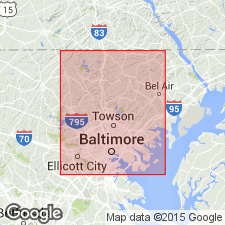
- Usage in publication:
-
- Hydes Marble Member
- Modifications:
-
- Named
- Dominant lithology:
-
- Marble
- AAPG geologic province:
-
- Piedmont-Blue Ridge province
Summary:
Loch Raven Schist of Wissahickon Group named in this report and divided into two formally named members and several unnamed mineral facies. The Hydes Marble Member is named for a tiny village located in a carbonate lowland of about 7.5 sq km known as Long Green in east-central Baltimore Co., MD. Rocks were originally assigned to the Cockeysville Marble by Mathews and Miller (1905). Author believes that they are actually a lens within the Loch Raven and younger than the Cockeysville. The member crops out in only about a dozen places and information has been supplemented by data from seven test borings. Four rock types can be distinguished: clean metalimestone, phlogopitic metalimestone, metadolostone, and calc-silicate fels. Relative abundance of rock types and areal extent has not been determined. The clean metalimestone is a sparkling, snow-white, massive rock consisting almost wholly of calcite. The phlogopitic metalimestone is a calcite marble with abundant phlogopite and small amounts of other silicates. The metadolomite is typically a pure, white, fine-grained rock consisting largely of dolomite and locally containing minor calcite and tremolite. The calc-silicate fels is a massive diopside-quartz rock. Thickness of the member can only be estimated. It ranges from 0 to probably not more than 300 meters. Age of the entire Wissahickon Group is shown as Cambrian-Ordovician(?).
Source: GNU records (USGS DDS-6; Reston GNULEX).
For more information, please contact Nancy Stamm, Geologic Names Committee Secretary.
Asterisk (*) indicates published by U.S. Geological Survey authors.
"No current usage" (†) implies that a name has been abandoned or has fallen into disuse. Former usage and, if known, replacement name given in parentheses ( ).
Slash (/) indicates name conflicts with nomenclatural guidelines (CSN, 1933; ACSN, 1961, 1970; NACSN, 1983, 2005, 2021). May be explained within brackets ([ ]).

